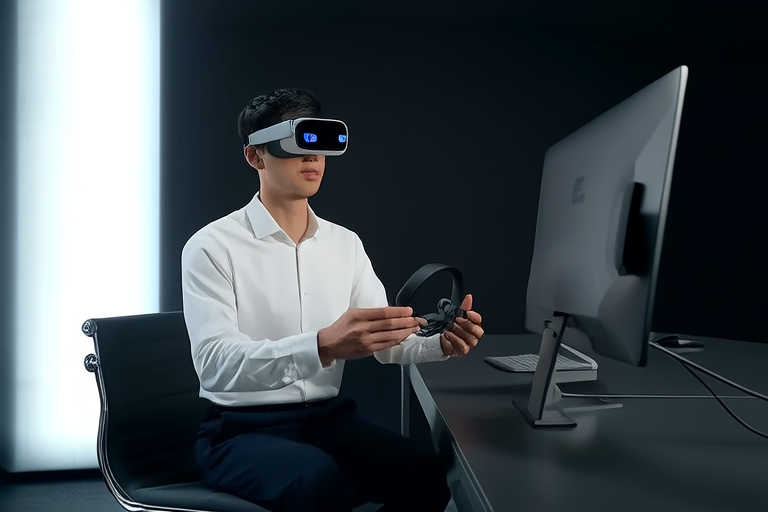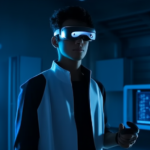Introduction
In an era defined by rapid technological advancements, Virtual Reality (VR) and Augmented Reality (AR) stand out as transformative forces redefining the boundaries of human interaction with reality. VR immerses users in entirely digital environments, simulating experiences that feel tangible and real. AR, on the other hand, overlays digital elements onto the physical world, enhancing our perception of reality. Together, these technologies are reshaping how we interact with information, entertainment, and even each other. By creating immersive and interactive experiences, VR and AR are not just tools but gateways to new dimensions of reality, offering limitless possibilities for innovation across industries.
The Evolution of VR and AR
The journey of VR and AR has been marked by significant milestones and technological breakthroughs. The concept of VR dates back to the 1960s, with Ivan Sutherland’s “Sword of Damocles,” widely regarded as the first head-mounted display system. However, it wasn’t until the 1990s that VR gained public attention through arcade games and early consumer devices like Nintendo’s Virtual Boy. Despite initial limitations, advancements in computing power and graphics processing have propelled VR into mainstream adoption.
AR, meanwhile, emerged as a distinct field in the late 20th century, with early experiments focusing on military and industrial applications. The release of Google Glass in 2013 brought AR to the forefront of consumer technology, though its limited functionality and privacy concerns hindered widespread adoption. More recently, innovations such as Microsoft’s HoloLens and AR-enabled smartphones have demonstrated the potential of blending digital content with the real world. Today, both VR and AR benefit from improvements in hardware, software, and connectivity, enabling increasingly sophisticated and accessible experiences.
Applications Across Industries
VR and AR are revolutionizing numerous sectors by providing innovative solutions to longstanding challenges. In healthcare, VR is transforming medical training and patient care. Surgeons use VR simulations to practice complex procedures, while patients benefit from immersive therapies for pain management and mental health treatment. AR, meanwhile, assists doctors during surgeries by overlaying critical information directly onto their field of view.
In education, VR creates immersive learning environments that make abstract concepts tangible. Students can explore historical landmarks, dive into the depths of the ocean, or travel through the solar system—all from the safety of their classrooms. Similarly, AR enhances textbooks and lectures by adding interactive 3D models and visual aids, fostering deeper engagement and understanding.
The gaming industry has long embraced VR, offering players unprecedented levels of immersion. Titles like “Beat Saber” and “Half-Life: Alyx” showcase the medium’s potential for storytelling and gameplay innovation. Beyond gaming, AR apps like Pokémon GO have demonstrated how digital content can seamlessly integrate with the real world, captivating millions of users worldwide.
In real estate, VR enables virtual property tours, allowing buyers to explore homes remotely. AR complements this by visualizing renovations or furniture placements within existing spaces. Retailers also leverage AR to enhance shopping experiences; customers can virtually try on clothes or see how furniture would look in their homes before making a purchase.
Enhancing Human Experience
VR and AR are not just tools for specialized industries—they are reshaping everyday life by enhancing human experiences in profound ways. Entertainment has been transformed by VR’s ability to transport users into fully realized worlds. Whether attending a live concert, exploring fantastical landscapes, or participating in interactive narratives, VR offers unparalleled immersion.
Virtual travel is another area where these technologies shine. For those unable to physically visit distant locations, VR provides an alternative way to experience iconic destinations. Meanwhile, AR enriches local exploration by offering guided tours, historical insights, and interactive maps overlaid onto real-world views.
Training simulations powered by VR and AR are proving invaluable in fields requiring hands-on expertise. Pilots, soldiers, and emergency responders use these technologies to hone skills in safe yet realistic environments. Remote work is also being reimagined, with AR-enhanced collaboration tools enabling teams to share virtual workspaces and manipulate 3D objects in real-time.
Challenges and Limitations
Despite their promise, VR and AR face several challenges that must be addressed to achieve broader adoption. Technical constraints remain a significant hurdle. High-quality VR experiences often require powerful hardware, which can be expensive and cumbersome. Motion sickness, caused by discrepancies between visual input and physical movement, continues to affect some users.
Accessibility is another concern. While prices for VR and AR devices are gradually decreasing, they remain out of reach for many individuals. Additionally, creating compelling content for these platforms demands specialized skills and resources, limiting the availability of diverse applications.
Ethical considerations also arise with the growing integration of VR and AR into daily life. Privacy issues are particularly pertinent, as AR devices collect vast amounts of data about users’ surroundings. There are also concerns about the psychological impact of prolonged exposure to virtual environments, including desensitization and detachment from reality.
Societal implications cannot be ignored. As VR and AR blur the lines between the physical and digital worlds, questions emerge about identity, authenticity, and social norms. Ensuring equitable access and responsible usage will be crucial as these technologies continue to evolve.
Future Prospects
The future of VR and AR holds immense potential, driven by emerging trends and ongoing innovations. Advances in artificial intelligence and machine learning are expected to enhance the realism and interactivity of virtual environments. Haptic feedback systems, which simulate touch, will further deepen immersion, making digital interactions feel more lifelike.
5G networks and edge computing will play pivotal roles in enabling seamless, high-fidelity experiences. These technologies will reduce latency and improve connectivity, paving the way for cloud-based VR and AR applications accessible via lightweight devices.
As VR and AR become more integrated into our lives, they will likely redefine how we perceive and navigate the world. Concepts like the metaverse—a collective virtual space where users interact through avatars—hint at a future where digital and physical realities coexist harmoniously. Such developments could transform everything from commerce and communication to governance and culture.
Conclusion
VR and AR are undeniably reshaping our perception of reality, offering boundless opportunities for innovation and growth. From enhancing education and healthcare to revolutionizing entertainment and remote work, these technologies are already making a profound impact across industries. However, realizing their full potential requires addressing current challenges, including technical limitations, accessibility barriers, and ethical dilemmas.
As we look to the future, it is essential to approach VR and AR with both enthusiasm and responsibility. By fostering inclusive development and mindful implementation, we can harness their power to create meaningful, positive change. Ultimately, VR and AR remind us that reality is not fixed—it is malleable, dynamic, and ripe for exploration. The boundaries between the physical and digital worlds may continue to blur, but the choices we make today will shape the landscapes of tomorrow.


